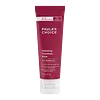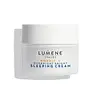What's inside
What's inside
 Key Ingredients
Key Ingredients

 Benefits
Benefits

 Concerns
Concerns

 Ingredients Side-by-side
Ingredients Side-by-side

Water
Skin ConditioningPropylene Glycol Dicaprylate/Dicaprate
EmollientButylene Glycol
HumectantGlycerin
HumectantSorbitan Stearate
EmulsifyingCaprylic/Capric Triglyceride
MaskingCetearyl Alcohol
EmollientGlyceryl Stearate
EmollientDicaprylyl Carbonate
EmollientEthyl Macadamiate
Skin ConditioningCyclopentasiloxane
EmollientCyclohexasiloxane
EmollientGlyceryl Behenate/Eicosadioate
EmollientBorago Officinalis Seed Oil
EmollientOenothera Biennis Oil
EmollientOlea Europaea Fruit Oil
MaskingPrunus Armeniaca Fruit
AstringentGlycine Soja Sterols
EmollientTocopheryl Acetate
AntioxidantTocopherol
AntioxidantTetrahexyldecyl Ascorbate
AntioxidantAscorbyl Palmitate
AntioxidantLinoleic Acid
CleansingPhospholipids
Skin ConditioningSodium Hyaluronate
HumectantRetinyl Palmitate
Skin ConditioningSodium Dilauramidoglutamide Lysine
HumectantCetearyl Glucoside
EmulsifyingSclerotium Gum
Emulsion StabilisingHectorite
AbsorbentCaprylyl Glycol
EmollientEthylhexylglycerin
Skin ConditioningPhenoxyethanol
PreservativeWater, Propylene Glycol Dicaprylate/Dicaprate, Butylene Glycol, Glycerin, Sorbitan Stearate, Caprylic/Capric Triglyceride, Cetearyl Alcohol, Glyceryl Stearate, Dicaprylyl Carbonate, Ethyl Macadamiate, Cyclopentasiloxane, Cyclohexasiloxane, Glyceryl Behenate/Eicosadioate, Borago Officinalis Seed Oil, Oenothera Biennis Oil, Olea Europaea Fruit Oil, Prunus Armeniaca Fruit, Glycine Soja Sterols, Tocopheryl Acetate, Tocopherol, Tetrahexyldecyl Ascorbate, Ascorbyl Palmitate, Linoleic Acid, Phospholipids, Sodium Hyaluronate, Retinyl Palmitate, Sodium Dilauramidoglutamide Lysine, Cetearyl Glucoside, Sclerotium Gum, Hectorite, Caprylyl Glycol, Ethylhexylglycerin, Phenoxyethanol
Water
Skin ConditioningPrunus Amygdalus Dulcis Oil
Skin ConditioningHydrogenated Polydecene
EmollientOlus Oil
EmollientGlycerin
HumectantCetearyl Alcohol
EmollientLactococcus Ferment Lysate
Skin ConditioningOctyldodecyl Myristate
EmollientOleyl Erucate
EmollientCetyl Palmitate
EmollientGlyceryl Stearate
EmollientNiacinamide
SmoothingPEG-100 Stearate
Rubus Chamaemorus Seed Oil
Skin ConditioningRubus Chamaemorus Seed Extract
Skin ConditioningPhenoxyethanol
PreservativeHydrogenated Olive Oil
Skin ConditioningCetearyl Glucoside
EmulsifyingPropylheptyl Caprylate
EmollientTocopheryl Acetate
AntioxidantOlea Europaea Fruit Oil
MaskingPropanediol
SolventHippophae Rhamnoides Oil
EmollientAcrylates/C10-30 Alkyl Acrylate Crosspolymer
Emulsion StabilisingEthylhexylglycerin
Skin ConditioningAllantoin
Skin ConditioningOlea Europaea Oil Unsaponifiables
Skin ConditioningLecithin
EmollientTocopherol
AntioxidantPEG-8
HumectantXanthan Gum
EmulsifyingCaprylyl Glycol
EmollientMagnesium Ascorbyl Phosphate
AntioxidantRetinyl Palmitate
Skin ConditioningAlgae Extract
EmollientSodium Hyaluronate
HumectantLactic Acid
BufferingSodium Hydroxide
BufferingSodium Benzoate
MaskingSodium Chloride
MaskingAscorbyl Palmitate
AntioxidantPotassium Sorbate
PreservativeGlucose
HumectantAscorbic Acid
AntioxidantChondrus Crispus
MaskingCitric Acid
BufferingHelianthus Annuus Seed Oil
EmollientRosmarinus Officinalis Leaf Extract
AntimicrobialChondrus Crispus Extract
Skin ConditioningLimonene
PerfumingLinalool
PerfumingCitral
PerfumingParfum
MaskingWater, Prunus Amygdalus Dulcis Oil, Hydrogenated Polydecene, Olus Oil, Glycerin, Cetearyl Alcohol, Lactococcus Ferment Lysate, Octyldodecyl Myristate, Oleyl Erucate, Cetyl Palmitate, Glyceryl Stearate, Niacinamide, PEG-100 Stearate, Rubus Chamaemorus Seed Oil, Rubus Chamaemorus Seed Extract, Phenoxyethanol, Hydrogenated Olive Oil, Cetearyl Glucoside, Propylheptyl Caprylate, Tocopheryl Acetate, Olea Europaea Fruit Oil, Propanediol, Hippophae Rhamnoides Oil, Acrylates/C10-30 Alkyl Acrylate Crosspolymer, Ethylhexylglycerin, Allantoin, Olea Europaea Oil Unsaponifiables, Lecithin, Tocopherol, PEG-8, Xanthan Gum, Caprylyl Glycol, Magnesium Ascorbyl Phosphate, Retinyl Palmitate, Algae Extract, Sodium Hyaluronate, Lactic Acid, Sodium Hydroxide, Sodium Benzoate, Sodium Chloride, Ascorbyl Palmitate, Potassium Sorbate, Glucose, Ascorbic Acid, Chondrus Crispus, Citric Acid, Helianthus Annuus Seed Oil, Rosmarinus Officinalis Leaf Extract, Chondrus Crispus Extract, Limonene, Linalool, Citral, Parfum
 Reviews
Reviews

Ingredients Explained
These ingredients are found in both products.
Ingredients higher up in an ingredient list are typically present in a larger amount.
Ascorbyl Palmitate is created by combining pure Vitamin C and palmitic acid. It is an antioxidant and helps reduce hyperpigmentation.
This ingredient is a more stable version of Vitamin C, meaning it does not disintegrate as quickly when exposed to sunlight. However, studies show it does not penetrate skin as well as pure Vitamin C.
Ascorbyl Palmitate is oil soluble.
Read more about other types of Vitamin C:
Learn more about Ascorbyl PalmitateCaprylyl Glycol is a humectant and emollient, meaning it attracts and preserves moisture.
It is a common ingredient in many products, especially those designed to hydrate skin. The primary benefits are retaining moisture, skin softening, and promoting a healthy skin barrier.
Though Caprylyl Glycol is an alcohol derived from fatty acids, it is not the kind that can dry out skin.
This ingredient is also used as a preservative to extend the life of products. It has slight antimicrobial properties.
Learn more about Caprylyl GlycolCetearyl alcohol is a mixture of two fatty alcohols: cetyl alcohol and stearyl alcohol. It is mainly used as an emulsifier. Emulsifiers help prevent the separation of oils and products. Due to its composition, it can also be used to thicken a product or help create foam.
Cetearyl alcohol is an emollient. Emollients help soothe and hydrate the skin by trapping moisture.
Studies show Cetearyl alcohol is non-toxic and non-irritating. The FDA allows products labeled "alcohol-free" to have fatty alcohols.
This ingredient is usually derived from plant oils such as palm, vegetable, or coconut oils. There is debate on whether this ingredient will cause acne.
Due to the fatty acid base, this ingredient may not be Malassezia folliculitis safe.
Learn more about Cetearyl AlcoholCetearyl Glucoside is a surfactant and emulsifier. It can be produced from synthetic of natural sources of cetearyl alcohol and glucose.
Emulsifiers help prevent ingredients from separating, such as oils and waters. It can also be used to enhance the texture of products.
As a surfactant, Cetearyl Glucoside helps during the cleansing process. By gathering all the dirt and oils, it allows these molecules to be washed away easily.
Learn more about Cetearyl GlucosideEthylhexylglycerin (we can't pronounce this either) is commonly used as a preservative and skin softener. It is derived from glyceryl.
You might see Ethylhexylglycerin often paired with other preservatives such as phenoxyethanol. Ethylhexylglycerin has been found to increase the effectiveness of these other preservatives.
Glycerin is already naturally found in your skin. It helps moisturize and protect your skin.
A study from 2016 found glycerin to be more effective as a humectant than AHAs and hyaluronic acid.
As a humectant, it helps the skin stay hydrated by pulling moisture to your skin. The low molecular weight of glycerin allows it to pull moisture into the deeper layers of your skin.
Hydrated skin improves your skin barrier; Your skin barrier helps protect against irritants and bacteria.
Glycerin has also been found to have antimicrobial and antiviral properties. Due to these properties, glycerin is often used in wound and burn treatments.
In cosmetics, glycerin is usually derived from plants such as soybean or palm. However, it can also be sourced from animals, such as tallow or animal fat.
This ingredient is organic, colorless, odorless, and non-toxic.
Glycerin is the name for this ingredient in American English. British English uses Glycerol/Glycerine.
Learn more about GlycerinGlyceryl Stearate is a mix of glycerin and stearic acid.
It is used to stabilize the mixing of water and oil ingredients. By preventing these ingredients from separating, it can help elongate shelf life. It can also help thicken the product's texture.
As an emollient, it helps soften skin and supports barrier-replenishing ingredients.
In cosmetics, Glyceryl Stearate is often made from vegetable oils or synthetically produced.
This ingredient may not be fungal-acne safe
Fun fact: The human body also creates Glyceryl Stearate naturally.
Learn more about Glyceryl StearateOlea Europaea Fruit Oil is the fixed oil obtained from the ripe fruit of the Olive. In other words - olive oil.
The primary contents of olive oil are glycerides of the fatty acids linoleic, oleic and palmitic.
Olive oil also contains antioxidants such as Vitamin E. Antioxidants may help reduce signs of aging by fighting unstable free-radical molecules. It also contains Vitamins A (retinol), D, and K.
The squalene in olive oil makes it a great emollient. Emollients help soothe and soften your skin by trapping moisture in. This makes olive oil a great skin moisturizer.
Studies show olive oil to have antibacterial and antifungal properties in low concentrations. Another study found olive oil irritated sensitive oily skin. We always recommend speaking with a professional about using this ingredient in your routine.
Due to the fatty acid content, this ingredient may not be fungal-acne safe.
Learn more about Olea Europaea Fruit OilPhenoxyethanol is a preservative that has germicide, antimicrobial, and aromatic properties. Studies show that phenoxyethanol can prevent microbial growth. By itself, it has a scent that is similar to that of a rose.
It's often used in formulations along with Caprylyl Glycol to preserve the shelf life of products.
Retinyl palmitate is a form of retinoid. Retinoids are the superstar class of anti-aging ingredients that include tretinoin and retinol.
This particular ingredient has had a bumpy year with its rise and fall in popularity.
First, Retinyl palmitate is created from palmitic acid and retinol. It is a retinol ester and considered one of the weaker forms of retinoid.
This is because all retinoids have to be converted to Tretinoin, AKA retinoic acid. Retinyl Palmitate is pretty far down the line and has to go through multiple conversions before its effects are seen.
Due to this long and ineffective conversion line, the benefits of Retinyl Palmitate are debated.
Studies show Retinyl Palmitate to help:
Dermatologists say this ingredient is ineffective because it isn't used in high enough concentrations in cosmetics.
This ingredient used to be found in sunscreens to boost the efficacy of sunscreen filters.
The downfall of Retinyl Palmitate was due to released reports about the ingredient being correlated to sun damage and skin tumors.
While there is a study showing this ingredient to cause DNA damage when exposed to UV-A, there is no concrete proof of it being linked to skin cancer. It is safe to use when used correctly.
All retinoids increase your skin's sensitivity to the sun in the first few months of usage. Be especially careful with reapplying sunscreen when using any form of retinoid.
Currently, this ingredient is still allowed in cosmetics all over the world. In Canada, cosmetics must have a warning label stating the product to contain Retinyl Palmitate
Fun fact: This ingredient is often added to low-fat milk to increase the levels of Vitamin A.
Learn more about Retinyl PalmitateSodium Hyaluronate is hyaluronic acid's salt form. It is commonly derived from the sodium salt of hyaluronic acid.
Like hyaluronic acid, it is great at holding water and acts as a humectant. This makes it a great skin hydrating ingredient.
Sodium Hyaluronate is naturally occurring in our bodies and is mostly found in eye fluid and joints.
These are some other common types of Hyaluronic Acid:
Learn more about Sodium HyaluronateTocopherol (also known as Vitamin E) is a common antioxidant used to help protect the skin from free-radicals and strengthen the skin barrier. It's also fat soluble - this means our skin is great at absorbing it.
Vitamin E also helps keep your natural skin lipids healthy. Your lipid skin barrier naturally consists of lipids, ceramides, and fatty acids. Vitamin E offers extra protection for your skin’s lipid barrier, keeping your skin healthy and nourished.
Another benefit is a bit of UV protection. Vitamin E helps reduce the damage caused by UVB rays. (It should not replace your sunscreen). Combining it with Vitamin C can decrease sunburned cells and hyperpigmentation after UV exposure.
You might have noticed Vitamin E + C often paired together. This is because it is great at stabilizing Vitamin C. Using the two together helps increase the effectiveness of both ingredients.
There are often claims that Vitamin E can reduce/prevent scarring, but these claims haven't been confirmed by scientific research.
Learn more about TocopherolTocopheryl Acetate is AKA Vitamin E. It is an antioxidant and protects your skin from free radicals. Free radicals damage the skin by breaking down collagen.
One study found using Tocopheryl Acetate with Vitamin C decreased the number of sunburned cells.
Tocopheryl Acetate is commonly found in both skincare and dietary supplements.
Learn more about Tocopheryl AcetateWater. It's the most common cosmetic ingredient of all. You'll usually see it at the top of ingredient lists, meaning that it makes up the largest part of the product.
So why is it so popular? Water most often acts as a solvent - this means that it helps dissolve other ingredients into the formulation.
You'll also recognize water as that liquid we all need to stay alive. If you see this, drink a glass of water. Stay hydrated!
Learn more about Water